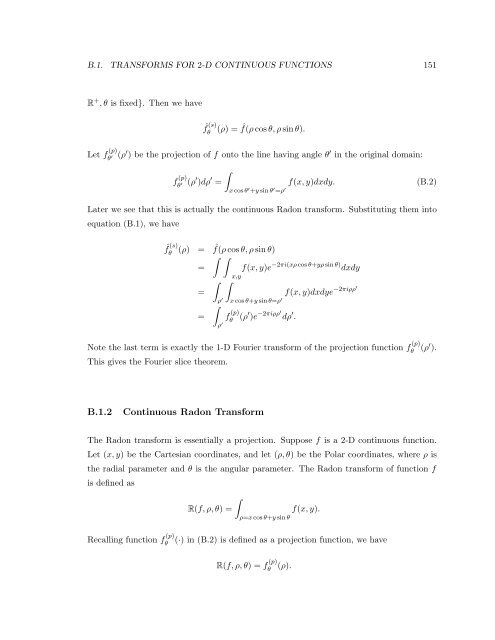sparse image representation via combined transforms - Convex ...
sparse image representation via combined transforms - Convex ...
sparse image representation via combined transforms - Convex ...
Create successful ePaper yourself
Turn your PDF publications into a flip-book with our unique Google optimized e-Paper software.
B.1. TRANSFORMS FOR 2-D CONTINUOUS FUNCTIONS 151<br />
R + ,θ is fixed}. Thenwehave<br />
ˆf (s)<br />
θ<br />
(ρ) = ˆf(ρ cos θ, ρ sin θ).<br />
Let f (p)<br />
θ<br />
(ρ ′ ) be the projection of f onto the line having angle θ ′ in the original domain:<br />
′<br />
∫<br />
f (p)<br />
θ<br />
(ρ ′ )dρ ′ =<br />
f(x, y)dxdy.<br />
′<br />
x cos θ ′ +y sin θ ′ =ρ ′<br />
(B.2)<br />
Later we see that this is actually the continuous Radon transform. Substituting them into<br />
equation (B.1), we have<br />
ˆf (s)<br />
θ<br />
(ρ) = ˆf(ρ cos θ, ρ sin θ)<br />
∫ ∫<br />
= f(x, y)e −2πi(xρ cos θ+yρ sin θ) dxdy<br />
=<br />
x,y<br />
∫<br />
f(x, y)dxdye<br />
∫ρ ′ x cos θ+y sin θ=ρ<br />
∫<br />
′<br />
= f (p)<br />
θ<br />
(ρ ′ )e −2πiρρ′ dρ ′ .<br />
ρ ′<br />
Note the last term is exactly the 1-D Fourier transform of the projection function f (p)<br />
θ<br />
(ρ ′ ).<br />
This gives the Fourier slice theorem.<br />
B.1.2<br />
Continuous Radon Transform<br />
The Radon transform is essentially a projection. Suppose f is a 2-D continuous function.<br />
Let (x, y) be the Cartesian coordinates, and let (ρ, θ) be the Polar coordinates, where ρ is<br />
the radial parameter and θ is the angular parameter. The Radon transform of function f<br />
is defined as<br />
∫<br />
R(f,ρ,θ) =<br />
f(x, y).<br />
ρ=x cos θ+y sin θ<br />
Recalling function f (p)<br />
θ<br />
(·) in (B.2) is defined as a projection function, we have<br />
R(f,ρ,θ) =f (p)<br />
θ<br />
(ρ).
















